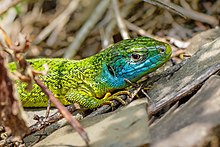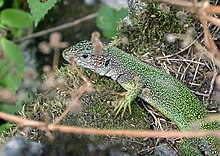| Western green lizard | |
|---|---|

| |
| Male | |

| |
| Female | |
| Conservation status | |
 Least Concern (IUCN 3.1) | |
| Scientific classification | |
| Domain: | Eukaryota |
| Kingdom: | Animalia |
| Phylum: | Chordata |
| Class: | Reptilia |
| Order: | Squamata |
| Family: | Lacertidae |
| Genus: | Lacerta |
| Species: | L. bilineata |
| Binomial name | |
| Lacerta bilineata Daudin, 1802 | |

| |
| The western green lizard is in green The eastern green lizard is in blue | |
| Synonyms | |
| |
The western green lizard (Lacerta bilineata) is a lizard of the family Lacertidae.
Etymology
The genus name Lacerta and the species name bilineata are Latin words respectively meaning “lizard” and “with two lines”, with reference to the pale lines present on the flanks of the young individuals.
Subspecies
- Lacerta bilineata bilineata Daudin, 1802 (in Spain, France, Switzerland and Germany)
- Lacerta bilineata chloronota Rafinesque-Schmaltz, 1810 (in southern Italy and Sicily)
- Lacerta bilineata chlorosecunda Taddei, 1950 (in southeastern Italy)
- Lacerta bilineata fejervaryi Vasvary, 1926 (in Italy from Tuscany up to Naples)
Distribution
It is native in Andorra, Croatia, France, Germany, Italy, Monaco, Serbia, Slovenia, Spain, Switzerland, Guernsey and Jersey in the Channel Isles. and introduced into the United States. There are also introduced colonies on the south coast of the U.K, notably around Poole Bay in Dorset.
Description
Lacerta bilineata reaches an average length (excluding tail) of about 13 centimetres (5.1 in), with a maximum of 40 centimetres (16 in), including tail. The tail may reach up to twice the body length. The average weight is about 35 grams. The body is bright green. The head is bigger in males than in females, and the males often show a blue throat. Juveniles are almost brown, with a yellowish belly and two to four pale, longitudinal lines along the flanks. Sub-adults also have these lines, together with several small brown spots on their backs.
-
 Male of Lacerta bilineata
Male of Lacerta bilineata
-
Lacerta bilineata regenerating its previously shed tail (autotomy)
-
 Close-up
Close-up
-
 Close-up
Close-up
-
 Coupling
Coupling
These lizards are territorial animals. They attain sexual maturity at around two years, when they are about 8 cm long (excluding tail). The males fight each other, especially during the mating period, when they are very aggressive towards rivals. The mating ritual is precise, and starts with a bite to the base of the female's tail. The females lay 6 to 25 eggs in a humid and warm site, such as in a decomposing log. The average life span of this species is about 15 years.
They feed on arthropods, like large insects, isopods and spiders.
Habitat
Its natural habitats are green humid areas, temperate forest, the edges of woods, shrubland, open grassland, arable land, and pastureland. It is threatened by habitat loss.
References
- Valentin Pérez-Mellado; Marc Cheylan; Philippe Geniez; et al. (2009). "Lacerta bilineata". IUCN Red List of Threatened Species. 2009: e.T61519A12501065. doi:10.2305/IUCN.UK.2009.RLTS.T61519A12501065.en. Retrieved 17 November 2021.
- ^ Biolib
- ^ Reptiles & Amphibiens de France
- Angelici, Francesco Maria; Luiselli, Luca; Rugiero, Lorenzo (January 1997). "Food habits of the green lizard, Lacerta bilineata , in central Italy and a reliability test of faecal pellet analysis". Italian Journal of Zoology. 64 (3): 267–272. doi:10.1080/11250009709356207.